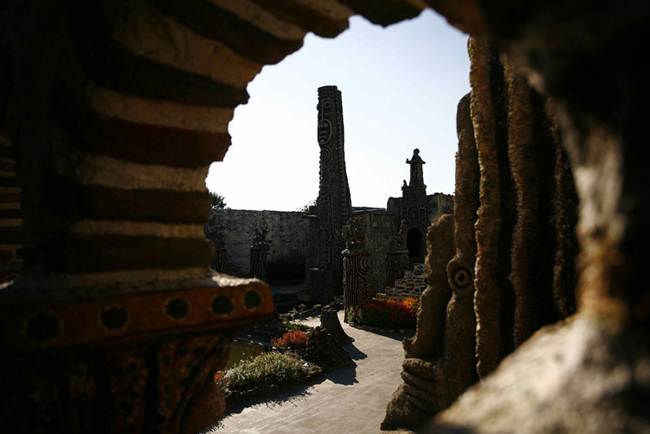Robert Tatin is sculptor, painter, ceramist, architect, decorator, carpenter, poet, tailor, baker and bargemen. He and his last wife retired in west-central France. He spent 21 years of his life in creating a " Sculpture home." Now the house is open to the public. Primitive, big-eyed caryatids. To the north stands the statue 6 meters high, symbolizing the connection between heaven and earth. Its base has its roots in "the water of life." To the east "Sun Gate" is faced with a "Western Gateway to the Moon", "Gateway Giant" - a high relief representing the five major for Robert Tatina painters: Rembrandt, Van Gogh, Leonardo da Vinci , Goya and Delacroix. Dragon -simvolichesky entrance in the heart of the museum, is situated like a sentinel, it is also the keeper of knowledge. House couples, where they lived for twenty-one years. Now it is a museum of Robert Tatin.
Robert Tatin was born on January 9, 1902 in the French countryside. At age 16 he moved to Paris and worked as a painter and decorator. During this same time, he studied drawing and painting, attending free schools. He enrolled in the School of Fine Arts in Paris and at the rates of monumental painting at the School of Applied Arts. flickr/Nicolas Degauque
From 1922 to 1924 Tatin left for military service in Chartres. After the service, he established a construction company, which enabled him to travel often. He visited several countries in Europe, North Africa, and New York in 1938. In 1945, deeply affected by the horrors of war, he decided to become an artist. In 1950, Tatin decides to leave France. He went to Brazil and worked as a painter, sculptor and ceramist.
In 1951 Tatin exhibited at the First Biennial of Sao Paulo and won the first prize for sculpture. It then crosses South America: Argentina, Uruguay, Paraguay and Chile to Tierra del Fuego. During his travels, he comes into contact with the Native Americans and expands svoyreestr shapes and colors. When he returned to France in 1955, he worked in Paris. In 1961 he won the Critics Award in Paris. In 1962, at age 60, Robert Tatin bought a small house in Cosse-le-Vivien and begins the construction of his house with his fifth and last wife, Lisa. He died in 1983, Robert.
flickr/Maria Willems
flickr/Sud Mayenne tourisme
flickr/ECHOES IN THE WONDERLAND
flickr/Nicolas Degauque
flickr/ECHOES IN THE WONDERLAND
flickr/Nicolas Degauque
flickr/ian williams
flickr/Sébastien Brothier









No comments:
Post a Comment